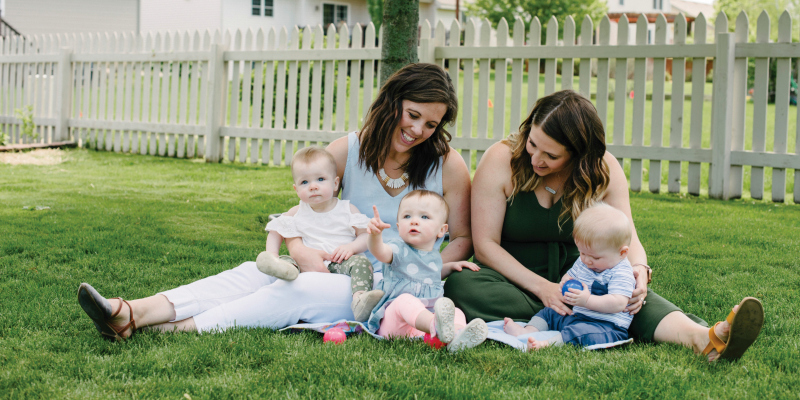By Emily McCluhan | Photographed by Hillary Schave
When Erin Elliott and Kelli Massey met in college, they didn’t know that a few years later they’d become each other’s support system, shoulder to cry on and even consider each other family as they both tried to create families of their own.
“Both Erin and I thought that’s what happens when you get married. You get pregnant, you make babies. But it didn’t happen,” Massey says.
Ultimately both families conceived through in vitro fertilization, but as Elliott and Massey learned, there are many layers to every IVF story.
Elliott and her husband Erik knew they wanted to have kids a few months into marriage when Erin’s niece was born, about six years ago.
“We started trying and did that for about a year, but no luck. I started seeing my doctor and getting all the tests done which all came back fine. Just unexplained infertility,” Elliott says with frustration.
She decided to reach out to Wisconsin Fertility Institute on the recommendation of a friend and eventually did two rounds of Intrauterine Insemination (IUI). It starts with medication and shots to stimulate the egg follicles, then sperm is injected directly into the uterus. Although IUI has a low success rate, it’s less expensive and less invasive than IVF. When IUI didn’t work, Elloitt’s doctor recommended IVF.
As Elliott started down the IVF road, Massey was also trying to conceive and not having success.
She made an appointment at Wisconsin Fertility but then got pregnant and miscarried. Soon she began her own path through IUIs and eventually to IVF.
What both gals come back to is that many people don’t know how intense the IVF process is until you are in it.
“What most people don’t realize is that when you talk about ‘doing fertility,’ medication and IUI are at one end of the spectrum and IVF is way over on the other end,” Elliott says. The biggest hurdle, she says, is the financial one.
When faced with the nearly $20,000 price tag, both women say that because the process is already in motion, you just figure the finances out.
Besides the financial commitment, there are the ups and downs, the grief and the joy. Elliott and Massey look at each other amazed that they’ve forgotten some of the steps or gloss over these events that completely changed their lives.
There’s prepping your body for egg retrieval with medication and hormone shots into the stomach. Then the retrieval itself. Then, the anticipation and waiting on phone calls from the clinic to tell you how many eggs were fertilized. Then, the weeks of preparing for the egg transfer, including injections of an oily progesterone concoction directly into the butt muscle with a huge needle. And waiting for your body chemicals to be just right to accept the transfer. Then the transfer itself which is hopefully the point of conception. Then the waiting.
As each woman went through all of these steps (some of them more than once), they became as close as sisters. Elliott initially had eight fertilized embryos after the egg retrieval, but her first three transfers failed.
“That first one was probably the most devastating because we had gone to this step and it was a huge deal. And there’s no reason this isn’t working,” she recalls. After further testing, she found out that only three of the remaining five embryos were viable.
“I had done progesterone shots in my butt so many times and was just done. So, my doctor suggested we transfer two embryos at once. And yeah…it worked! Twins!” she says, still surprised.
As Massey and her husband Alex moved from IUI to IVF, Elliott created a binder for her friend covering all 15 steps of the IVF process with a fun gift at each milestone. And after Massey’s first transfer ended in a miscarriage, Elliott showed up for her second transfer, pregnant with twins, dressed in a clown costume.
“During my first transfer, Kelli joked about having an IVF clown because the doctors always say you must stay relaxed and laugh,” says Elliott. “So yeah, I was there when Theo was conceived, in a clown costume!”
Elliott and Massey agree that having a strong support system, whether it’s friends, family, Facebook groups or meetings at a fertility clinic, is one of the most important factors for getting through IVF.
“The worst thing to do is just dump all of your struggles on your husband,” says Massey. “We joke that Erin and I were basically married through all of this because we would just call each other and ask questions or cry.” But they acknowledge the growth they’ve seen in both of their husbands and agree that all of them are better parents because of this process.
“There were two years where I had very little control over my life. You’re at the mercy of when your body is ready. So, when the clinic calls, you go. You learn to let go of that control before baby even happens,” Massey says.
They both joke that the biggest difference now that they have babies is they can make plans and travel.
Will they try for more babies?
“We don’t have any embryos left, so if we can’t get pregnant naturally, we’d have to start over with the retrieval. That definitely stresses me out, but I think we’ll start trying again soon,” Massey says.
Elliott has one embryo left and also wants to try to get pregnant naturally but struggles with the idea of hav- ing that potential human sitting out there in storage.
“Before it was just an embryo, but now there’s a tie to it because I have children from those embryos,” she says. “I also have to pay a $400 per year storage fee.”
Elliott and Massey tick off the options for Elliott’s embryo: transfer it and see if it works, donate it to science, donate it to a family that needs it.
For these two women who knew they wanted babies, it became a matter of hope and pushing until they got the outcome they wanted.
Elliott says that along the way, they knew they controlled the end of their IVF story.
“We may not get to control all the steps in the process, but we get to control the end.”





Comments are closed.